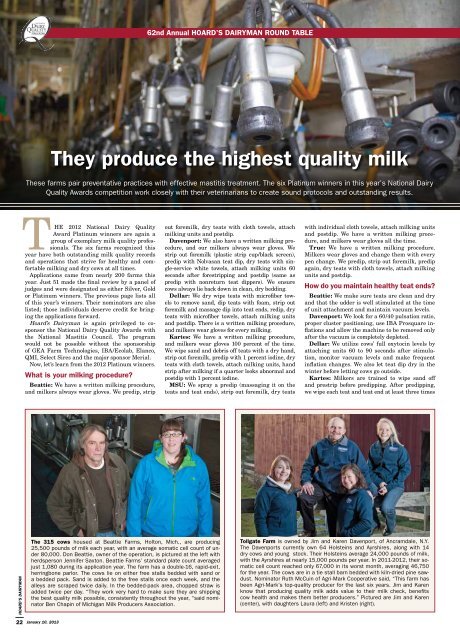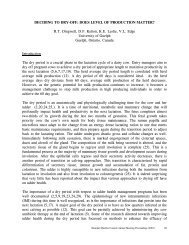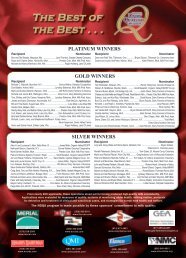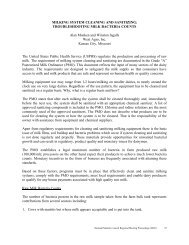round table discussion - National Mastitis Council
round table discussion - National Mastitis Council
round table discussion - National Mastitis Council
Create successful ePaper yourself
Turn your PDF publications into a flip-book with our unique Google optimized e-Paper software.
HOARD’S DAIRYMAN<br />
The 2012 <strong>National</strong> Dairy Quality<br />
Award Platinum winners are again a<br />
group of exemplary milk quality professionals.<br />
The six farms recognized this<br />
year have both outstanding milk quality records<br />
and operations that strive for healthy and comfor<strong>table</strong><br />
milking and dry cows at all times.<br />
Applications came from nearly 200 farms this<br />
year. Just 51 made the final review by a panel of<br />
judges and were designated as either Silver, Gold<br />
or Platinum winners. The previous page lists all<br />
of this year’s winners. Their nominators are also<br />
listed; those individuals deserve credit for bringing<br />
the applications forward.<br />
hoard’s Dairyman is again privileged to cosponsor<br />
the <strong>National</strong> Dairy Quality Awards with<br />
the <strong>National</strong> <strong>Mastitis</strong> <strong>Council</strong>. The program<br />
would not be possible without the sponsorship<br />
of GeA Farm Technologies, IBA/ecolab, elanco,<br />
QMI, Select Sires and the major sponsor Merial.<br />
Now, let’s learn from the 2012 Platinum winners.<br />
What is your milking procedure?<br />
Beattie: We have a written milking procedure,<br />
and milkers always wear gloves. We predip, strip<br />
22 January 10, 2013<br />
They produce the highest quality milk<br />
These farms pair preventative practices with effective mastitis treatment. The six Platinum winners in this year’s <strong>National</strong> Dairy<br />
Quality Awards competition work closely with their veterinarians to create sound protocols and outstanding results.<br />
The 315 cows housed at Beattie Farms, Holton, Mich., are producing<br />
25,500 pounds of milk each year, with an average somatic cell count of under<br />
80,000. Don Beattie, owner of the operation, is pictured at the left with<br />
herdsperson Jennifer Saxton. Beattie Farms’ standard plate count averaged<br />
just 1,080 during its application year. The farm has a double-16, rapid-exit,<br />
herringbone parlor. The cows lie on either free stalls bedded with sand or<br />
a bedded pack. Sand is added to the free stalls once each week, and the<br />
alleys are scraped twice daily. In the bedded-pack area, chopped straw is<br />
added twice per day. “They work very hard to make sure they are shipping<br />
the best quality milk possible, consistently throughout the year, “said nominator<br />
Ben Chapin of Michigan Milk Producers Association.<br />
62nd Annual HOARD’S DAIRYMAN ROUND TABLE<br />
out foremilk, dry teats with cloth towels, attach<br />
milking units and postdip.<br />
Davenport: We also have a written milking procedure,<br />
and our milkers always wear gloves. We<br />
strip out foremilk (plastic strip cup/black screen),<br />
predip with Nolvasan teat dip, dry teats with single-service<br />
white towels, attach milking units 60<br />
seconds after forestripping and postdip (same as<br />
predip with nonreturn teat dippers). We ensure<br />
cows always lie back down in clean, dry bedding.<br />
Dellar: We dry wipe teats with microfiber towels<br />
to remove sand, dip teats with foam, strip out<br />
foremilk and massage dip into teat ends, redip, dry<br />
teats with microfiber towels, attach milking units<br />
and postdip. There is a written milking procedure,<br />
and milkers wear gloves for every milking.<br />
Kartes: We have a written milking procedure,<br />
and milkers wear gloves 100 percent of the time.<br />
We wipe sand and debris off teats with a dry hand,<br />
strip out foremilk, predip with 1 percent iodine, dry<br />
teats with cloth towels, attach milking units, hand<br />
strip after milking if a quarter looks abnormal and<br />
postdip with 1 percent iodine.<br />
MSU: We spray a predip (massaging it on the<br />
teats and teat ends), strip out foremilk, dry teats<br />
with individual cloth towels, attach milking units<br />
and postdip. We have a written milking procedure,<br />
and milkers wear gloves all the time.<br />
True: We have a written milking procedure.<br />
Milkers wear gloves and change them with every<br />
pen change. We predip, strip out foremilk, predip<br />
again, dry teats with cloth towels, attach milking<br />
units and postdip.<br />
How do you maintain healthy teat ends?<br />
Beattie: We make sure teats are clean and dry<br />
and that the udder is well stimulated at the time<br />
of unit attachment and maintain vacuum levels.<br />
Davenport: We look for a 60/40 pulsation ratio,<br />
proper cluster positioning, use IBA Prosquare inflations<br />
and allow the machine to be removed only<br />
after the vacuum is completely depleted.<br />
Dellar: We utilize cows’ full oxytocin levels by<br />
attaching units 60 to 90 seconds after stimulation,<br />
monitor vacuum levels and make frequent<br />
inflation changes. We also let teat dip dry in the<br />
winter before letting cows go outside.<br />
Kartes: Milkers are trained to wipe sand off<br />
and prestrip before predipping. After predipping,<br />
we wipe each teat and teat end at least three times<br />
Tollgate Farm is owned by Jim and Karen Davenport, of Ancramdale, N.Y.<br />
The Davenports currently own 64 Holsteins and Ayrshires, along with 14<br />
dry cows and young stock. Their Holsteins average 24,000 pounds of milk,<br />
with the Ayrshires at nearly 15,000 pounds per year. In 2011-2012, their somatic<br />
cell count reached only 67,000 in its worst month, averaging 46,750<br />
for the year. The cows are in a tie stall barn bedded with kiln-dried pine sawdust.<br />
Nominator Ruth McCuin of Agri-Mark Cooperative said, “This farm has<br />
been Agri-Mark’s top-quality producer for the last six years. Jim and Karen<br />
know that producing quality milk adds value to their milk check, benefits<br />
cow health and makes them better producers.” Pictured are Jim and Karen<br />
(center), with daughters Laura (left) and Kristen (right).





